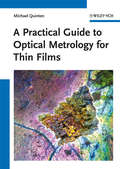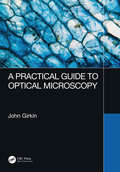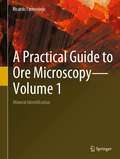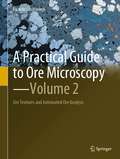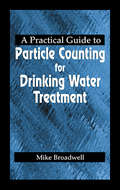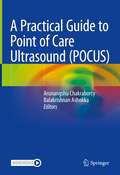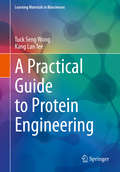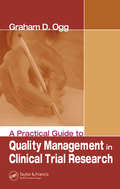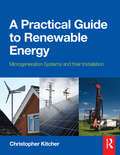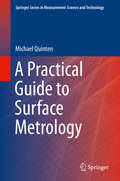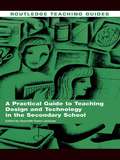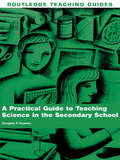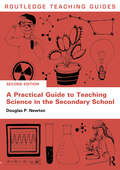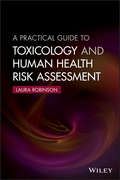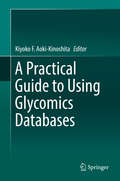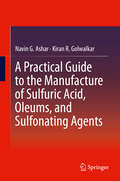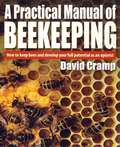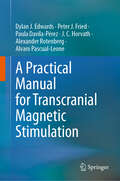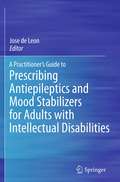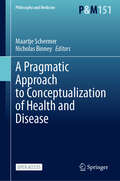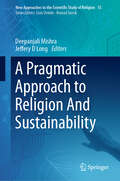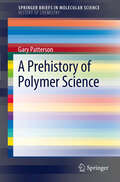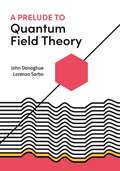- Table View
- List View
A Practical Guide to Optical Metrology for Thin Films
by Michael QuintenA one-stop, concise guide on determining and measuring thin film thickness by optical methods. This practical book covers the laws of electromagnetic radiation and interaction of light with matter, as well as the theory and practice of thickness measurement, and modern applications. In so doing, it shows the capabilities and opportunities of optical thickness determination and discusses the strengths and weaknesses of measurement devices along with their evaluation methods. Following an introduction to the topic, Chapter 2 presents the basics of the propagation of light and other electromagnetic radiation in space and matter. The main topic of this book, the determination of the thickness of a layer in a layer stack by measuring the spectral reflectance or transmittance, is treated in the following three chapters. The color of thin layers is discussed in chapter 6. Finally, in chapter 7, the author discusses several industrial applications of the layer thickness measurement, including high-reflection and anti-reflection coatings, photolithographic structuring of semiconductors, silicon on insulator, transparent conductive films, oxides and polymers, thin film photovoltaics, and heavily doped silicon. Aimed at industrial and academic researchers, engineers, developers and manufacturers involved in all areas of optical layer and thin optical film measurement and metrology, process control, real-time monitoring, and applications.
A Practical Guide to Optical Microscopy
by John GirkinOptical microscopy is used in a vast range of applications ranging from materials engineering to in vivo observations and clinical diagnosis, and thanks to the latest advances in technology, there has been a rapid growth in the number of methods available. This book is aimed at providing users with a practical guide to help them select, and then use, the most suitable method for their application. It explores the principles behind the different forms of optical microscopy, without the use of complex maths, to provide an understanding to help the reader utilise a specific method and then interpret the results. Detailed physics is provided in boxed sections, which can be bypassed by the non-specialist. It is an invaluable tool for use within research groups and laboratories in the life and physical sciences, acting as a first source for practical information to guide less experienced users (or those new to a particular methodology) on the range of techniques available. Features: The first book to cover all current optical microscopy methods for practical applications Written to be understood by a non-optical expert with inserts to provide the physical science background Brings together conventional widefield and confocal microscopy, with advanced non-linear and super resolution methods, in one book
A Practical Guide to Ore Microscopy—Volume 1: Mineral Identification
by Ricardo CastroviejoThis book offers a guide to the microscopic study of metallic ores with reflected light. It combines a rigorous approach with an attractive and easy-to-follow format, using high-quality calibrated photomicrographs to illustrate the use of color for ore identification. The ore identification methodology is updated with systematic color analysis and the application of new multispectral reflectance datasets, which offer an efficient tool for automated ore characterization. In addition, the first volume of this two-part work discusses the essential gangue minerals.Readers will gain familiarity with the method as they follow its application to over 200 selected minerals, comprising the most important ore (≈150) and gangue (≈50) minerals, which are described in the text. Each entry includes an explanatory text with corresponding color photomicrographs for each of the most common microscope settings, preceded by a table summarizing the ore’s main properties, and followed by spectral information in the visible and near-infrared ranges (specular reflectance values from 370 to 1000 nm). Some uncommon, strategic ores, e.g. columbotantalite (“coltan”) and monazite, receive particular attention or are described for the first time with reflected light.Lastly, the book presents a learning strategy for beginners and students. The approach is essentially practical, focusing on the development of observation skills, including self-checking through proposed practical tasks. In addition, the traditional use of determinative tables is critically reviewed and updated.This book is part of a two-volume work. The second volume focuses on intergrowths/textural analysis and interpretation, as well as computer-vision-based automation and applications to ore processing/geometallurgy.The intended audience includes professionals and engineers dealing with mineral resources, as well as postgraduate students. The book also provides lifelong learning support for freelancers and a valuable reference resource for practical university teaching.
A Practical Guide to Ore Microscopy—Volume 2: Ore Textures and Automated Ore Analysis
by Ricardo CastroviejoThis book presents recent developments in ore microscopy to support the work of engineers and scientists actively engaged in the field of mineral raw materials (processing plant engineers in mines, process mineralogists and chemists, exploration geologists, etc.) or in ore deposit research. Textural analysis must be rigorous, and simple to be practical. With this aim, the author proposes a specific and user-friendly systematic for textural analysis. A high-performance tool to acquire, quantify, and process the data applied for automated ore characterization is key to predict ore behavior, a fundamental aim of geometallurgy. The recently developed AMCO System (Automated Microscopic Characterization of Ores) provides the tool, first prototype available using computer vision coupled with reflected light microscopy. This innovation is introduced in the text and discussed through case studies of actual mining problems.This second volume of the book "A Practical Guide to Ore Microscopy" includes references, indexes, and other relevant information, plus Annexes 1 to 5. The latter include ore and gangue mineral indexes and mineral abbreviations (Annex 1), a brief compendium of common mineral associations in the main ore deposit types (Annex 2), an introduction to the procedures and techniques used to prepare polished sections (Annex 3), and the various tables used to identify common ores by direct microscopic observation (Annexes 4 and 5).
A Practical Guide to Particle Counting for Drinking Water Treatment
by John Michael BroadwellAs EPA standards for water quality have tightened in recent years, the need to more accurately assess filter performance and improve the overall treatment process has led to increased demand for the high sensitivity provided by particle counters. One particle counter can give you more data than a dozen turbidimeters-if you know how to sort through
A Practical Guide to Point of Care Ultrasound (POCUS)
by Arunangshu Chakraborty Balakrishnan AshokkaThis book covers point of care ultrasound (POCUS) in a practical, problem oriented and illustrated manner. It begins with introduction to the basic principles of medical ultrasound imaging and ultrasound guided interventions and outlines point of care ultrasound in a lucid manner for rapid learning for medical students as well as practitioners. It contains chapters on ultrasound of the airways, thoracic ultrasound including lungs and transthoracic screening echocardiogram, vascular assessment, ultrasound of the abdomen for focussed trauma assessment, gastric volume assessment and ultrasound guided interventions such as vascular cannulations, pleurocentesis, etc. along with some of the latest point of care ultrasound techniques such as ocular assessment and assessment of the foetus and placenta in the operation theatre. This book will help the intensivist, emergency physician and anaesthesiologist to learn the basics of POCUS, which ostensibly, is the future of medical practice. It also includes objective structured clinical examination (OSCE) questions after every chapter as well as multiple choice questions (MCQs) that will benefit the students greatly. The book also includes videos from some of the celebrated practitioners of POCUS providing a unique learning experience. This book is suited for students, trainees and practitioners alike. The modules of POCUS described here are part of the curriculum of anaesthesiology in the UK, USA, Singapore, Australia/ New Zealand and most of the countries. The book also covers the curriculum of POCUS in critical care and emergency medicine courses.
A Practical Guide to Protein Engineering (Learning Materials in Biosciences)
by Tuck Seng Wong Kang Lan TeeThis textbook introduces readers in an accessible and engaging way to the nuts and bolts of protein expression and engineering. Various case studies illustrate each step from the early sequence searches in online databases over plasmid design and molecular cloning techniques to protein purification and characterization. Furthermore, readers are provided with practical tips to successfully pursue a career as a protein engineer. With protein engineering being a fundamental technique in almost all molecular biology labs, the book targets advanced undergraduates and graduate students working in molecular biology, biotechnology and related scientific fields.
A Practical Guide to Quality Management in Clinical Trial Research
by Graham OggSetting up a GXP environment where none existed previously is a very daunting task. Getting staff to write down what they do for every task is a correspondingly difficult and time-consuming exercise. Examining how to maintain quality control in clinical trial research, A Practical Guide to Quality Management in Clinical Trial Research provides a co
A Practical Guide to Renewable Energy: Power Systems and their Installation
by Christopher KitcherThe renewable energy field is an area of rapid growth with many government initiatives in place to encourage mainstream take-up of energy-saving technologies in buildings. In the UK, over 100,000 students per year undertake plumbing and electrical installation vocational courses that will be directly affected by these developments. More importantly, there will be an even greater number of professionals studying toward renewable energy installation and inspection courses that need this information. This new book from bestselling author Chris Kitcher provides an overview of all of the latest technologies and how they can be incorporated. Students and professionals will use it on a range of courses and as a reference on-site.
A Practical Guide to Surface Metrology (Springer Series in Measurement Science and Technology)
by Michael QuintenThis book offers a genuinely practical introduction to the most commonly encountered optical and non-optical systems used for the metrology and characterization of surfaces, including guidance on best practice, calibration, advantages and disadvantages, and interpretation of results. It enables the user to select the best approach in a given context. Most methods in surface metrology are based upon the interaction of light or electromagnetic radiation (UV, NIR, IR), and different optical effects are utilized to get a certain optical response from the surface; some of them record only the intensity reflected or scattered by the surface, others use interference of EM waves to obtain a characteristic response from the surface. The book covers techniques ranging from microscopy (including confocal, SNOM and digital holographic microscopy) through interferometry (including white light, multi-wavelength, grazing incidence and shearing) to spectral reflectometry and ellipsometry. The non-optical methods comprise tactile methods (stylus tip, AFM) as well as capacitive and inductive methods (capacitive sensors, eddy current sensors).The book provides: Overview of the working principlesDescription of advantages and disadvantagesCurrently achievable numbers for resolutions, repeatability, and reproducibilityExamples of real-world applications A final chapter discusses examples where the combination of different surface metrology techniques in a multi-sensor system can reasonably contribute to a better understanding of surface properties as well as a faster characterization of surfaces in industrial applications. The book is aimed at scientists and engineers who use such methods for the measurement and characterization ofsurfaces across a wide range of fields and industries, including electronics, energy, automotive and medical engineering.
A Practical Guide to Teaching Design and Technology in the Secondary School
by Gwyneth Owen-JacksonContaining a wealth of practical activities and materials that provide excellent opportunities to analyse learning and performance within Design and Technology, this book also includes case studies and examples of existing good practice and a range of tried-and-tested strategies. Specially designed to be written in directly it provides a useful record of progress and is accompanied by a Companion Website. Designed to be used by student teachers, NQTs and beginning teachers, this workbook covers each main specialist area of Design Technology: electronics and communications technology (ECT), food technology, materials technology and textiles technology. Topics covered include: design and technology in the school curriculum the importance of health and safety the use of ICT in the teaching of design and technology planning lessons managing the classroom assessment issues the integration of literacy, numeracy, citizenship and sustainability into design and technology your own professional development. This book complements the market-leading textbook Learning to Teach Design and Technology in the Secondary School (also published by Routledge), but can also be used equally successfully on its own.
A Practical Guide to Teaching Science in the Secondary School (Routledge Teaching Guides)
by Douglas P. NewtonThis practical and accessible workbook is designed to support student teachers as they develop their basic teaching skills and increase their broader knowledge and understanding for teaching science. Newly qualified and beginning teachers should also find it useful. It contains all the advice, guidance and resources new and student science teachers need to reflect on and develop their teaching practice, helping them to plan lessons across the subject in a variety of teaching situations. Helpful features include: case studies examples of pupils’ work examples of existing good practice a range of tried-and-tested teaching strategies photocopiable resources and training materials activities in each chapter to help student history teachers analyse their learning and performance web links for further reading on evidence-based practice.
A Practical Guide to Teaching Science in the Secondary School (Routledge Teaching Guides)
by Douglas P. NewtonA Practical Guide to Teaching Science in the Secondary School is designed to support student teachers as they develop their teaching skills and increase their broader knowledge and understanding for teaching science. It offers straightforward advice and inspiration on key topics such as planning, assessment, practical work, the science classroom, and on to the broader aspects of teaching science. This thoroughly updated second edition reflects on new expectations, requirements, and practices in science teaching, with chapters exploring key and contemporary topics such as: The nature of science and scientific argument The various kinds of thinking emphasised in science and how to exercise them How to engage students in learning Assessment for and of learning Diverse needs and how to meet them The use of technology to support teaching and learning Learning at a distance. Designed to be used independently or alongside the popular textbook Learning to Teach Science in the Secondary School, this book is packed with revised and updated case studies, examples of pupils' work, and resources and activities in every chapter. It provides everything trainee and early career teachers need to reflect on and develop their teaching practice, helping them to plan lessons across the subject in a variety of teaching situations.
A Practical Guide to Toxicology and Human Health Risk Assessment
by Laura RobinsonToxicology – the study of the adverse effects of chemicals on living organisms is the cornerstone to all aspects of chemical safety and knowledge of the subject is needed in a wide spectrum of fields from the chemical industry to medicine, emergency services, forensics, and regulatory science. Toxicology involves the study of symptoms, mechanisms, treatments and detection of poisoning ... especially the poisoning of people.The many problems arising from a poor understanding of toxicology and its applications in hazard communication and chemical safety motivated the author’s training courses and webinars, leading to this valuable book.Providing a practical and accessible guide, A Practical Guide to Toxicology and Human Health Risk Assessment enables readers to quickly build up knowledge and understanding of toxicology and its use in hazard identification, which is a fundamental part of chemical risk assessment. The book also covers current toxicological testing strategies and the use of physicochemical test data in hazard identification and exposure assessment.Examples are provided throughout the book to highlight important issues along with a summary of the key points that have been covered in each of the respective chapters. The book concludes with a listing of online resources on toxicology and risk assessment.
A Practical Guide to Using Glycomics Databases
by Kiyoko F. Aoki-KinoshitaThis book provides glycoscientists with a handbook of useful databases that can be applied to glycoscience research. Although many databases are now publicly available, one of the hurdles for their users is the learning curve required to effectively utilize those databases. Therefore, this book not only describes the existing databases, but also provides tips on how to obtain the target data. That is, because many databases provide a variety of data that could be obtained from different perspectives, each chapter provides users with potential biological questions that can be answered by a particular database and step-by-step instructions, with figures, on how to obtain that data. Troubleshooting tips are also provided to aid users encountering problems that can be predicted when using these databases. Moreover, contact information for each database is provided in case unexpected issues arise.
A Practical Guide to the Manufacture of Sulfuric Acid, Oleums, and Sulfonating Agents
by Navin G. Ashar Kiran R. GolwalkarThis critical volume provides practical insights on sulfuric acid and related plant design and on techniques to improve and enhance substantially the efficiency of an existing plant by means of small modifications. The book provides readers with a better understanding of the state-of-art in sulfuric acid manufacture as well as, importantly, in the manufacture of value-added products based on sulfur that are also associated with the manufacture of sulfuric acid. Overall, engineers and plant managers will be introduced to technologies for making their sulfuric acid enterprises more productive, remunerative, and environmentally friendly. A Practical Guide to the Manufacture of Sulfuric Acid, Oleums, and Sulfonating Agents covers sulfuric acid and derivative chemical plant details from the nuts-and-bolts level to a holistic perspective based on actual field experience. The book is indispensable to anyone involved in implementing a sulfuric acid or related chemical plant.
A Practical Introduction to Electrical Circuits
by John E. AyersA Practical Introduction to Electrical Circuits represents a fresh approach to the subject which is compact and easy to use, yet offers a comprehensive description of the fundamentals, including Kirchhoff’s laws, nodal and mesh analysis, Thevenin and Norton’s theorems, and maximum power transfer for both DC and AC circuits, as well as transient analysis of first- and second-order circuits. Advanced topics such as mutual inductance and transformers, operational amplifier circuits, sequential switching, and three-phase systems reinforce the fundamentals. Approximately one hundred solved examples are included within the printed copy. Extra features online include over two hundred additional problems with detailed, step-by-step solutions, and 40 self-service quizzes with solutions and feedback.
A Practical Manual Of Beekeeping: How to Keep Bees and Develop Your Full Potential as an Apiarist
by David CrampA fascinating hobby; a remunerative business; or a globetrotting career? Which type of beekeeper do you want to be? It is entirely up to you: beekeeping can provide it all.Beekeeping can provide anyone with an interesting and useful hobby or a lucrative and rewarding business. It is recognised as a vital agricultural industry and can therefore also offer you a globe trotting career. The whole subject is, however, often shrouded in mystery and loaded with jargon, leaving many people unaware of its true potential or how to start. This book strips away all the mystery and explains step by step how - from day one - you can start beekeeping as a hobby; how you can progress to running a beekeeping business; or how you can start a career as a beekeeper which can quite easily take you all over the world. No other guide explains in such detail the true potential and accessibility of beekeeping or of being a beekeeper.
A Practical Manual Of Beekeeping: How to Keep Bees and Develop Your Full Potential as an Apiarist
by David CrampA fascinating hobby; a remunerative business; or a globetrotting career? Which type of beekeeper do you want to be? It is entirely up to you: beekeeping can provide it all.Beekeeping can provide anyone with an interesting and useful hobby or a lucrative and rewarding business. It is recognised as a vital agricultural industry and can therefore also offer you a globe trotting career. The whole subject is, however, often shrouded in mystery and loaded with jargon, leaving many people unaware of its true potential or how to start. This book strips away all the mystery and explains step by step how - from day one - you can start beekeeping as a hobby; how you can progress to running a beekeeping business; or how you can start a career as a beekeeper which can quite easily take you all over the world. No other guide explains in such detail the true potential and accessibility of beekeeping or of being a beekeeper.
A Practical Manual for Transcranial Magnetic Stimulation
by Alvaro Pascual-Leone Alexander Rotenberg Dylan J. Edwards Peter J. Fried Paula Davila-Pérez Jared C. HorvathThis practical guide to transcranial magnetic stimulation (TMS) offers step-by-step instruction for the most commonly used TMS protocols in humans. TMS equipment is increasingly available in University and Hospital settings and even small clinics. TMS protocols are often taken from disparate publications, and there has not been a single comprehensive and practical reference for the most common procedures. The current book contains structured steps for the various TMS protocols in addition to relevant fundamental information, including a practical summary of principles of TMS and a glossary of terms. This book is designed to be a quick reference on the office or clinic desk, or in the laboratory, and would be as useful for guiding research and clinical laboratory activities as it would for deciphering TMS study methodologies in the literature.
A Practitioner's Guide to Prescribing Antiepileptics and Mood Stabilizers for Adults with Intellectual Disabilities
by Jose De LeonEmotional, behavioral, and neuropsychiatric conditions are common in individuals with intellectual disabilities (IDs), most notably epilepsy, aggression, self-injurious behaviors, and bipolar and other mood disorders. Despite the prevalence of such problems, there is a scarcity in the literature of reliable information on medical treatments for those with IDs. A Practitioner's Guide to Prescribing Antiepileptics and Mood Stabilizers for Adults with Intellectual Disabilities provides a detailed framework for prescribing for this challenging population. Featuring the most up-to-date information on factors that inform prescribing, the Guide addresses basic issues and controversies (e.g., the rift between evidence-based and personalized medicine) in treating adults with cognitive deficits. Clients' specific needs are emphasized in developing appropriate and effective pharmacological intervention for improved outcomes and quality of life. Drugs discussed in the Guide include carbamazepine, clonazepam, diazepam, ethosuximide, felbamate, gabapentin, lacosamide, lamotrigine, levetiracetam, lithium, lorazepam, oxcarbazepine, phenobarbital, phenytoin, pregabalin, primidone, rufinamide, tiagabine, topiramate, valproate, and zonisamide. For each of these compounds, the guidelines cover: Indications for use; relative and absolute contraindications.Assessment during treatment; therapeutic drug monitoring; warning signs and symptoms for caretakers.Dosage: administration; initial and maximum recommended dosage; modifications associated with drug-drug interactions, personal characteristics, and (where appropriate) genetic variations.Adverse drug reactions: common, relatively uncommon, and potentially lethal, plus risk of metabolic syndrome.Guidelines for discontinuation.References, tables, and drug utilization reviews.A Practitioner's Guide to Prescribing Antiepileptics and Mood Stabilizers for Adults with Intellectual Disabilities is an indispensable decision-making reference for psychiatrists, neuropsychologists, psychopharmacologists, neurologists, internists, and clinical psychologists.
A Pragmatic Approach to Conceptualization of Health and Disease (Philosophy and Medicine #151)
by Maartje Schermer Nicholas BinneyThis open access book is an integrated historical and philosophical investigation of several problematic situations that emerge from diverse areas of medical practice. These include (but are not limited to): Paying less attention to patients who are suffering with symptoms because no identifiable pathological lesion or pathophysiological process can be found. Paying too much attention to patients who are not suffering with symptoms because pathological lesions or pathophysiological processes have been found. The tendency to understand patients at risk of developing pathology as being diseased. The tendency to disregard the importance of wider societal consequences of definitions of disease and health. The book shows that many of these problems are related to what disease and health are considered to be and argues that these problems can be addressed by reconsidering the concepts of health and disease employed in practice. It argues for a pragmatic reconceptualization of health and disease that allows clinicians, researchers, and lay people to understand health and disease in many ways, depending on the specific context in which they find themselves and the problems they are trying to solve. In doing so, authors are careful to show how this pragmatism does not endorse “silly” forms of relativism, in which knowledge is reduced to belief or to whatever people find expedient to believe. This work is relevant for philosophers and historians a well as for doctors, health policy makers and other health professionals because it addresses problems sourced from medical practice, albeit using philosophical and historical methods.
A Pragmatic Approach to Religion And Sustainability (New Approaches to the Scientific Study of Religion #15)
by Deepanjali Mishra Jeffery D LongThis volume outlines various religious practices followed across the global south and highlights their correlation to sustainability. It features more than 30 chapters from scholars across diverse disciplines, including philosophy, economics, ethics, theology, sociology, ritual studies, and education. The interdisciplinary volume mines religious rituals and practices for answers that could aid and alleviate unsustainable lifestyles. Delving deep into the cultural practices of tribal religions in India, the book highlights humanistic elements to establish sustainable ways of thinking, feeling, acting, and being. Including perspectives from Buddhism, Judaism, Hinduism, Christianity, and tribal religious traditions, this book is a must for scholars interested in sustainability and religion in the global south.
A Prehistory of Polymer Science (SpringerBriefs in Molecular Science #2)
by Gary Patterson Carnegie Mellon UniversityPolymer science is now an active and thriving community of scientists, engineers and technologists, but there was a time, not so long ago, when there was no such community. The prehistory of polymer science helps to provide key insights into current issues and historical problems. The story will be divided into an ancient period ( from Greek times to the creation of the molecular consensus), a nascent period (from Dalton to Kekule to van't Hoff) and a period of paradigm formation and controversy (from Staudinger to Mark to Carothers). The prehistory concludes with an account of the epochal 1935 Discussion of the Faraday Society on "Polymerization". After this meeting an active community engaged in trying to solve the central problems defined by the discussions.
A Prelude to Quantum Field Theory
by John Donoghue Lorenzo SorboA concise, beginner-friendly introduction to quantum field theoryQuantum field theory is a powerful framework that extends quantum mechanics in ways that are essential in many modern applications. While it is the fundamental formalism for the study of many areas of physics, quantum field theory requires a different way of thinking, and many newcomers to the subject struggle with the transition from quantum mechanics. A Prelude to Quantum Field Theory introduces the key concepts of quantum field theory in a brief and accessible manner while never sacrificing mathematical rigor. The result is an easy-to-use textbook that distills the most general properties of the theory without overwhelming beginning students with more advanced applications.Bridges quantum mechanics and quantum field theory, emphasizing analogies and differencesEmphasizes a “quantum field theoretical mindset” while maintaining mathematical rigorObtains quantum fields as the continuum limit of a quantized system of many particlesHighlights the correspondence between wave function—fundamental in quantum mechanics—and the formalism of second quantization used in quantum field theoryProvides a step-by-step derivation of Feynman rules for the perturbative study of interacting theoriesIntroduces students to renormalization, path integrals techniques, and moreDiscusses more modern topics like effective field theoriesIdeal for both undergraduate and graduate studentsProven in the classroom
